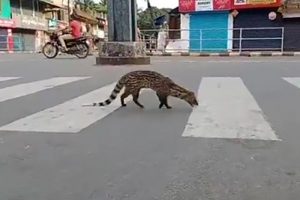Wild Visitors In The Time Of Corona
Residents of the northern Indian city of Noida, 26 km from Delhi — who were housebound like everyone else on account of the 21-day countrywide lockdown from March 25 against the novel coronavirus — were startled to hear hoofbeats outside late one evening.
Looming into view was a nilgai – or blue bull, Asia’s largest antelope – clip-clopping on the street outside the Great India Place Mall, apparently having strayed into the city centre from a small woodland on the outskirts.

Such a sighting was possibly unprecedented in normally bustling Noida, just as that of a small Indian civet trundling along the main road of the southern Indian city of Kozhikode, or that of a large sambar deer stag foraging in a parking lot in the northern city of Chandigarh. A muster of peafowl paid a visit to a housing society in India’s financial capital city of Mumbai, while a leopard was sighted at the air force base in Bihta in the northern state of Bihar. Emboldened by the deserted roads, a full-grown tiger treaded some 150 km from its territory in the Sanjay-Dubri Tiger Reserve in the state of Madhya Pradesh to reach Bihar’s Kaimur Wildlife Sanctuary.
As the dreaded Covid-19 pandemic rampages across the world, taking lives, crippling economies and reshaping the global order, its possibly solitary positive fallout has been the revival of the natural world in our midst. As India undergoes the world’s biggest lockdown – quanrantining its population of 1.3 billion – its rich heritage of wildlife is rejoicing. In normal times, its 350 mammalian species and 1,224 avian species are woefully conflicted with humans, as habitations, farms and industry expand into their realm.
Pollution, for now, is on the retreat as human activity like air, road and rail transport, industry, business, construction work and even venturing outdoors stands suspended for the first time ever in large swathes of the world. India, it seems, breathes free again as its people are suddenly witnessing clear skies, breathing clean air and hearing the sounds of birds even in cities.
Not only has life on land been rejuvenated, albeit temporarily, by falling pollution levels,even the marine ecosystem appears to have been resuscitated, as fishing and shipping activities decrease.

A social media post about a pod of Indian Ocean humpback dolphins frolicking on the deserted shores of normally congested Mumbai went viral, the spectacle not unprecedented but nevertheless rare. There was also unconfirmed footage of humpback whales swimming near the surface of the sea off Mumbai.
While it is difficult to quantify the decline in pollution wrought by the extensive disruption of routine life in India, the transformation in the quality of life has been palpable.India, after all, has been the third most polluting country, after China and the United States, these three countries contributing over half the world pollution.
However, even prior to the lockdown, phased shutdowns around the country were starting to have an impact. In the national capital of New Delhi, concentrations of particulate matter, PM2.5 -which is less than 2.5 micrometres in diameter and can lodge into the lungs and pass into the bloodstream – reportedly dropped from 91 to 26 microgrammes per cubic metre (cu m) by 27 March. The World Health Organization (WHO) considers levels above 25 to be unsafe. Nitrogen dioxide (NO2) similarly fell from 52 to 15 per cu m. Mumbai, Chennai, Kolkata and Bangalore also recorded drops in these inhalable air pollutants. Just last November, people had taken to the streets in New Delhi to protest the levels of air pollution, after the city was enveloped in a yellow haze for days, forcing the closure of schools and diversions of flights.
The suspension of all air traffic from 23 March too is having a profound effect on air quality in the country, as its civil aviation sector emits an estimated 28 million tonnes of CO2, while contributing more than$70 billion to the national GDP. Globally,airlines contribute to about 2 to 5 percent of greenhouse-gas emissions.
India’s air has become cleaner also because of the shrunken demand for electrical power, which is responsible for half the CO2 emissions in the country.Three-fourths of the power generated in the country is from fossil fuels,making its energy system one of the world’s dirtiest. Since the lockdown began, demand for power has crashed by almost a third, falling by 50,000 megawatts (MW) on a baseload power demand of 160,000 MW.
Unfortunately, unkindness towards domestic animals came to the fore as the Mumbai municipality strung up ill-advised posters across the city highlighting WHO’s website warning to people on Covid-19: “Keep away from pets…” This led to widespread abandonment of pets far from their homes. As a result, pedigree dogs and cats were found mange-ridden, dehydrated and starving by animal shelters that took them in.
On the other hand, India also unwittingly turned kinder towards animals amid rumors that Covid-19 can be transmitted through the consumption of chicken, meat and eggs. As a result, the poultry industry alone has been losing about $200 million of business daily, with the wholesale prices of chicken plummeting 70 per cent, affecting 20 million employees.
Marine life too is being spared the depradations of commercial fishery, as consumption has dropped with the closure of eating places. With a total fleet of 248,000 fishing vessels and with 15 million people employed in fisheries, India is the world’s largest aquaculture producer, after China, and had exported over 14.4 million tonnes of marine products worth nearly $7 billion in 2018-19.
With wildlife appearing dramatically in urban environs, there are those who are cautioning others that once the lockdown is over, they should check whether a reptile or bird has made its transit house inside their garages or vehicles, as a king cobra had coiled itself snugly into the handlebar of a long-parked motorcycle and an Indian thrush had made its nest in a side mirror of a car.

